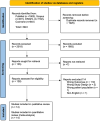Depressive symptoms after surgical and medical management of OSA: a systematic review and meta-analysis
- PMID: 39725719
- PMCID: PMC11671573
- DOI: 10.1007/s11325-024-03235-6
Depressive symptoms after surgical and medical management of OSA: a systematic review and meta-analysis
Abstract
Purpose: To evaluate the effect of CPAP and surgical alternatives for OSA on depression and compare the results of surgery to CPAP. METHODS: COCHRANE Library, CINAHL, PubMed, and Scopus databases were searched for English-language articles. Meta-analysis of continuous measures (mean), proportions (%), and mean difference (Δ) with 95% confidence interval was conducted for objective and subjective outcomes before and after treatment with CPAP or surgical interventions.
Results: We identified 2018 abstracts, 14 studies (N = 3,488) were included in the meta-analysis. Both treatments witnessed significant improvement in Apnea-hypopnea Index (AHI), with similar improvement with CPAP (Δ-48.8 [-51.2, -46.4]) and surgical interventions (Δ -20.22 [-31.3, -9.17]). An improvement in Epworth Sleepiness Scale (ESS) was noted between groups with (Δ -3.9 [-6.2, -1.6]) for the CPAP group and (Δ -4.3 [-6.0, -2.5]) for surgical interventions. The improvement of BDI II depression scores pre- and post-treatment was comparable between treatments with (Δ -4.1 [-5.8, -2.4]) for the CPAP group and (Δ- 5.6 [-9.2, -2.0]) for surgical interventions.
Conclusion: Our findings suggest a reduction in AHI is seen in both CPAP and surgical interventions for OSA, with no difference in AHI reduction between groups. Both treatments also lead to a similar improvement in depression scores providing strong evidence regards impact of surgery on OSA-associated mood disorders. While percent reduction in depression is higher in the surgical group, the difference did not reach statistical significance when compared to CPAP. When stratified by surgical intervention, most interventions suggest an improvement in depression scores.
Keywords: CPAP; Depression; OSA; Sleep surgery.
© 2024. This is a U.S. Government work and not under copyright protection in the US; foreign copyright protection may apply.
Conflict of interest statement
Declarations. Ethical approval: All procedures performed in studies involving human participants were in accordance with the ethical standards of the institutional and/or national research at Medical University of South Carolina and with the 1964 Helsinki declaration and its later amendments or comparable ethical standards. For this type of study formal consent is not required. Conflict of interest: All authors certify that they have no affiliations with or involvement in any organization or entity with any financial interest (such as honoraria; educational grants; participation in speakers’ bureaus; membership, employment, consultancies, stock ownership, or other equity interest; and expert testimony or patent-licensing arrangements), or non-financial interest (such as personal or professional relationships, affiliations, knowledge or beliefs) in the subject matter or materials discussed in this manuscript.
Figures




Similar articles
-
Continuous Positive Airway Pressure vs Mandibular Advancement Devices in the Treatment of Obstructive Sleep Apnea: An Updated Systematic Review and Meta-Analysis.Cureus. 2022 Jan 31;14(1):e21759. doi: 10.7759/cureus.21759. eCollection 2022 Jan. Cureus. 2022. PMID: 35251830 Free PMC article. Review.
-
The presence of insomnia and depression contributes to the acceptance of an initial treatment trial of continuous positive airway pressure therapy in patients with obstructive sleep apnea.Sleep Breath. 2021 Dec;25(4):1803-1812. doi: 10.1007/s11325-020-02266-z. Epub 2021 Jan 7. Sleep Breath. 2021. PMID: 33411189
-
Educational, supportive and behavioural interventions to improve usage of continuous positive airway pressure machines in adults with obstructive sleep apnoea.Cochrane Database Syst Rev. 2020 Apr 7;4(4):CD007736. doi: 10.1002/14651858.CD007736.pub3. Cochrane Database Syst Rev. 2020. PMID: 32255210 Free PMC article.
-
Positional therapy for obstructive sleep apnoea.Cochrane Database Syst Rev. 2019 May 1;5(5):CD010990. doi: 10.1002/14651858.CD010990.pub2. Cochrane Database Syst Rev. 2019. PMID: 31041813 Free PMC article.
-
Polysomnography in patients with obstructive sleep apnea: an evidence-based analysis.Ont Health Technol Assess Ser. 2006;6(13):1-38. Epub 2006 Jun 1. Ont Health Technol Assess Ser. 2006. PMID: 23074483 Free PMC article.
Cited by
-
Impact of nasal modifications on sinonasal function after maxillomandibular advancement for obstructive sleep apnea.Sleep Breath. 2025 Feb 8;29(1):92. doi: 10.1007/s11325-025-03262-x. Sleep Breath. 2025. PMID: 39921700 Free PMC article.
References
Publication types
MeSH terms
LinkOut - more resources
Full Text Sources
Medical

